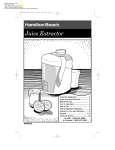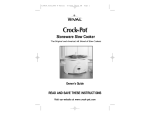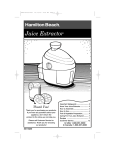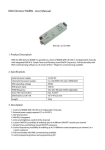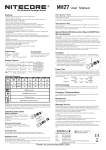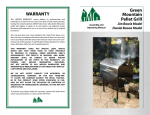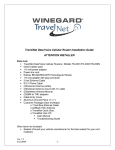Download Best of Southwestern Grilling
Transcript
Jane Butel’s Best of Southwestern Grilling: Meat, Poultry and Fish VOLUME 2: Best of Jane Butel www.janebutelcooking.com 505-2432622 [email protected] Edited and Produced by Linda Weissinger Lupowitz Copyright 2012. All contents copyrighted by TEX MEX, Inc. All rights reserved. No part of this document or the related files may be reproduced or transmitted in any form, by any means (electronic, photocopying, recording, or otherwise) without the prior written permission of the publisher. TableofContents Message from Jane Butel Grilled Meats: Beef and Lamb FAJITAS WITH ONION & TRICOLORED PEPPERS DALLAS-STYLE GRILLED FLANK STEAK JANE'S SPECIAL LAMB CHOPS GRILLED LEG OF LAMB A LA GRECQUE GRILLED SHORT RIBS, NEW MEXICO STYLE Grilled Pork JAMAICAN JERK-RUBBED GRILLED PORK RIBS GRILLED PORK CHOPS WITH CARAMELIZED ONIONS & ORANGE SALSA GRILLED SALSA-MARINATED PORK CHOPS GRILLED PORK PINWHEELS WITH FENNEL SALSA LEMON-BASTED PORK TENDERLOIN ROUNDS WITH WILTED SPINACH & PECANS Grilled Poultry SAGE & LEMON CHILE CHICKEN CHICKEN BREASTS WITH LEMONMUSTARD TARRAGON BASTE GRILLED CHICKEN BREAST WITH SUNDRIED TOMATO VINAIGRETTE OVER FUSILLI GRILLED CHICKEN WITH LEMONPECAN BUTTER LEMON-PECAN BUTTER HERB-BASTED DUCK WITH SEARED TURNIPS Grilled Fish GRILLED LAS CRUCES-STYLE TROUT WITH GREEN CHILE & PECAN STUFFING MARGARITA-MARINATED GRILLED RED SNAPPER GRILLING: Tips and Tricks FUEL SELECTION WHICH TYPE OF GRILL TO CHOOSE? CHARCOAL GRILLS GAS OR ELECTRIC GRILLS EQUIPMENT FOR GRILLING & SMOKING STARTING CHARCOAL FIRES RULES OF THUMB SAFETY TIPS GENERAL COOKING TIPS DONENESS DONENESS TEMPERATURES FOR BEEF DONENESS GUIDE FOR GRILLING BEEF DONENESS GUIDE FOR GRILLING PORK DONENESS GUIDE FOR GRILLING LAMB DONENESS GUIDE FOR GRILLING VEAL DONENESS GUIDE FOR GRILLING POULTRY DONENESS GUIDE FOR GRILLING FISH AND SEAFOOD Jane Butel Cooking School Message from Jane Butel Grilling is perhaps the most ancient of all cooking forms – especially for meat. It very well may be the very first cooking method on Earth, dating back to Paleolithic times and the discovery of fire. Americans used to think a “cookout” was hamburgers and hot dogs on the grill, but now, with current food trends toward lower-fat and lighter preparations, grilling fits right in. We had a great time developing and testing the recipes for the original Jane Butel’s Southwestern Grill – originally published in 1996. This new collection is a “Best of Southwestern Grilling” with an emphasis on the main event: grilled meats, poultry and seafood. Coming soon will be other collections of recipes for grilling whatever you can imagine, vegetables, side dishes, desserts, even bread. Grilling is fun – everything can be thrown on the grill, everyone can cook together, and no one need feel like a galley slave. In the summer—it’s a celebration and keeps the kitchen cool—however you can really grill year-round with indoor grills and stovetop grills or your broiler. Before starting to cook, review the final chapter in this book on grilling safety, equipment and cooking tips, pay special attention to the doneness temperatures and advice to enjoy grilling—trouble free without a worry about doneness! I’m Jane Butel – and I know you will enjoy this Best of Southwestern Grill – Now, get grilling! Jane Butel – http://janebutelcooking.com Grilled Meats: Beef and Lamb Fajitas with Onion and Tricolored Peppers Dallas-Style Grilled Flank Steak Jane's Special Lamb Chops Grilled Leg of Lamb a la Grecque Grilled Short Ribs Grilled meats are probably the most popular of all grilled foods. There are so many more variations that can add flavor and moisture than many cooks realize. Marinades are made from an acid-herb mixture with oil added for juiciness. At least 2 hours are needed to marinate and really add flavor. Beef at room temperature absorbs flavors far faster than when refrigerated: in fact, 2 hours at room temperature are the same as overnight in the refrigerator. Bastes are for adding flavor, and must be thick to adhere to the outside surface. Bastes have more oil, less acidic ingredients, and are loaded with herbs and spices. FAJITAS WITH ONION & TRICOLORED PEPPERS ^^^^^^^ Fajitas are now one of the most popular restaurant entrees, not only in Southwestern restaurants but in contemporary chains as well. They are best when the beef is grilled whole and sliced afterward. If outdoor grilling is out of the question due to weather or other limitations, they can be pan-broiled indoors. · 3 tablespoons freshly squeezed lime juice · 8 cloves garlic, minced · 3 to 4 tablespoons goodquality olive oil, preferably Spanish Freshly ground black pepper · 2 pounds beef bottom round or sirloin tip steaks, 1/4 to 3/8 inch thick · 1 large red onion, halved crosswise · 1 each red, green and yellow bell pepper, each cut into 8 wedges · 12 to 18 (6-inch) flour tortillas, warmed 1 recipe Aztec-Style Pico de Gallo with Chipotles · 1/2 cup sour cream (optional) Combine lime juice, garlic, 2 tablespoons of the olive oil and black pepper in a shallow bowl or heavy plastic bag. Pound meat to tenderize it and then place slices in bag. Allow to marinate at room temperature at least 30 minutes or meat can be frozen or refrigerated in marinade. Meanwhile · place onion and bell peppers on long skewers. Very lightly brush cut sides of onion with oil and whole surface of pepper pieces. Preheat grill to medium-high or 450F (230C) and place rack 4 inches above heat. To cook, place onion and pepper skewers on rack and grill until charred and softened, turning as needed. When vegetables are about done, place beef strips on rack and grill 1 to 2 minutes per side. To serve, slice beef and vegetables into strips about 1/2 inch wide. Serve in warm tortillas with Pico de Gallo and sour cream, if desired. Makes 6 to 8 servings. DALLAS-STYLE GRILLED FLANK STEAK ^^^^^^^ Flank steak is so easy to serve, it tends to be a pet of the barbecue bunch. Do remember some cardinal rules: Flank steak is very tough unless marinated in an acidic marinade and cooked only until medium rare at most—never well done. · 1/2 cup red wine · 1/4 cup finely minced onion · 3 cloves garlic, minced · 2 tablespoons Worcestershire sauce · teaspoon dry mustard · 1 tablespoon freshly squeezed lime juice · tablespoons crushed pequin chiles or other very hot chiles · 1 (1-1/2lb.) beef flank steak · 1 recipe salsa of your choice (optional) Combine wine, onion, garlic, Worcestershire sauce, mustard, lime juice and chiles in a shallow bowl or a heavy plastic bag. Trim any excess fat or sinew from outside of steak and then place steak in marinade, turning to coat both sides. Cover and refrigerate overnight or up to 3 days. You can freeze steak in the marinade if you wish. Preheat grill to medium-high or 450F (230C). Place rack 3 inches above heat. Lightly brush rack with oil and place steak on rack. Grill steak 3 to 5 minutes per side or until browned on outside and rare to medium rare on inside. Remove from grill and allow to stand about 20 minutes. Cut on the diagonal into thin slices. Serve with salsa, if desired. Makes 4 servings. JANE'S SPECIAL LAMB CHOPS ^^^^^^^ Very easy and oh so delicious! We have these when we want a satisfying quick dinner. · 4 to 6 lamb chops, either rib or loin, cut at least 1 inch thick 4 cloves garlic, minced · 2 teaspoons good-quality olive oil, preferably Spanish · 1 tablespoon fresh minced rosemary leaves, or 1-1/2 teaspoons dried rosemary · 1 tablespoon crushed caribe chile · Jalapeno jelly, preferably homemade Trim any hard fat from around the edge of each chop. Combine garlic, olive oil, rosemary and caribe chile in a small bowl. Spread garlic mixture thinly over surface of each chop. Allow to stand about 30 minutes. Preheat grill to high or broil, or 550F (270C). Place rack 3 to 4 inches above heat. Place chops on rack. Grill about 4 minutes per side or until browned on outside and rare to medium on inside. Makes 2 to 3 servings. GRILLED LEG OF LAMB A LA GRECQUE ^^^^^^^ I've long loved leg of lamb. Served with grilled fennel, carrots and potatoes, it's marvelous and often frequents our Easter table. · 1 (4- to 5-lb.) whole leg of lamb, butterflied and trimmed of hard fat and parchment-like covering · 8 cloves garlic, minced · 3 tablespoons freshly squeezed lemon juice · 3 to 4 tablespoons virgin olive oil, preferably Greek · 2 tablespoons fresh mint · · · · leaves or 2 teaspoons dried mint 2 tablespoons fresh oregano or 2 teaspoons dried oregano Freshly ground black pepper 2 heads fennel, quartered 8 to 10 carrots, halved 10 medium new potatoes, halved lengthwise Have butcher debone leg, telling him not to tie it. Combine garlic, lemon juice and 2 tablespoons of the olive oil in a small bowl. Spread half of mixture over inside surface of lamb, reserving remainder for outside. Place mint and oregano leaves inside lamb, roll and tie together with kitchen twine. Then, apply remaining garlic mixture. Season with black pepper. Allow to stand 2 hours at room temperature or overnight in the refrigerator. Preheat grill to medium-high or 450F (230C). If using charcoal, create two banks of coals for an indirect fire. If using electric or gas, then use the heating units at the sides only, not the middle, for best cooking. Place rack about 6 inches above heat. Roast 1 hour. Lightly brush vegetables with remaining olive oil and place on rack, covering grill if possible. Cook lamb until it reaches desired doneness or about 1-1/2 hours total cooking time for medium-rare, turning after 45 minutes. Grill vegetables until fork tender, turning as they cook. If using charcoal, replenish hot coals after 1 hour. Allow roast to stand about 20 minutes before carving. Makes 8 to 10 servings. GRILLED SHORT RIBS, NEW MEXICO STYLE ^^^^^^^ The marinade helps tenderize the short ribs and also adds a spicy flavor. · 1-1/2 cups dry red wine · 2 tablespoons goodquality olive oil, preferably Spanish · 1/2 cup finely chopped Spanish onion · 4 cloves garlic, minced · 1 teaspoon salt · Freshly ground black pepper · 2 bay leaves · 3 tablespoons ground pure New Mexico chile · 1/2 teaspoon ground cumin · 1/2 teaspoon ground Mexican oregano · 6 to 7 pounds meaty short ribs, trimmed Combine all ingredients except ribs in a shallow bowl or heavy plastic bag large enough to hold ribs. Stir to mix well. Add ribs and stir to coat evenly. Cover and marinate 2 hours or overnight. Preheat grill to medium or 350F (175C). If using charcoal, create two banks of coals for an indirect fire. If using electric or gas, then use the heating units at the sides only, not the middle, for best cooking. Place rack 6 to 8 inches above heat. Drain ribs, reserving marinade. Arrange ribs in center of grill, cover and cook about 20 minutes, then turn ribs and keep turning about every 10 minutes, basting with reserved marinade. Cook about 1 hour total or until ribs are browned on outside and slightly pink on inside. If you want them well done, reduce heat to low [220 to 225F (110C)] and continue cooking. Makes 8 to 10 servings. Grilled Pork Jamaican Jerk-Rubbed Grilled Pork Ribs Grilled Pork Chops with Caramelized Onions and Orange Salsa Grilled Salsa-Marinated Pork Chops Grilled Pork Pinwheels with Fennel Salsa Lemon-Basted Pork Tenderloins with Wilted Spinach & Pecans The most popular grilled pork dish – barbequed spareribs—is also one of America’s favorite dishes. Ribs have long been popular with barbeque sauce, of which there are so many variations – somewhat sweet, somewhat tart, maybe smoky or hot, with lots of mustard, runny to thick and so on. When grilling lean pork, such as the loin, always marinate and/or baste, and use moist or quick-cooking techniques to ensure the pork will not be overly dry and flavorless. JAMAICAN JERKRUBBED GRILLED PORK RIBS ^^^^^^^ The heavily-spiced jerk seasoning blend that has become so popular lately was developed by runaway slaves in the Caribbean. They found that the spicy blend kept pork fresh for several days, whereas otherwise it would not keep. · 1/3 cup water · 2 tablespoons rum · 2 tablespoons ground allspice 1-1/2 teaspoons ground cinnamon · 1 tablespoon ground · · · · · · coriander 3/4 teaspoon ground nutmeg 2 teaspoons ground turmeric 6 green onions, thinly sliced 3 cloves garlic, minced 1 fresh habanero (Scotch Bonnet) chile, minced or 1/2 to 1 teaspoon dried habanero chile, or, for milder heat, 1 teaspoon crushed pequin quebrado chile 1 teaspoon salt 3 pounds meaty countrystyle pork ribs Combine all the ingredients except the ribs in a blender in the order given. Process until blended, scraping down sides of bowl as necessary. Trim ribs of excess fat. Place ribs in a large, flat glass baking dish and, using a rubber scraper and tongs or rubber gloves, carefully coat both sides of ribs. Once covered with paste, refrigerate several · · hours or overnight or freeze up to 1 month in a heavy plastic bag or freezer container. Preheat grill to very high or broil, or 550F (270C). Place rack 4 inches above heat. Arrange ribs on rack. Grill 15 to 20 minutes per side or until a knife inserted in meatiest portion reveals firm, white not soft, pink meat or internal temperature is 170F (75C). Makes 6 to 8 servings. GRILLED PORK CHOPS WITH CARAMELIZED ONIONS & ORANGE SALSA ^^^^^^^ Onions and oranges are traditional complements to pork. Here their flavors are accented with the richness of sherry. · 4 (1/2-inch-thick) pork chops · 1 teaspoon vegetable oil · · · · · · 4 sprigs fresh sage or 11/2 teaspoons rubbed sage Freshly ground black or green pepper 1 large yellow or white onion, unpeeled and halved 1/4 cup sherry 2 seedless oranges 3 cloves garlic, roasted 2 tablespoons crushed caribe chile 1/2 teaspoon salt or to taste Trim excess fat from edges of chops, leaving at least a ¼ inch layer around sides. Lightly oil both sides of each pork chop. Then crush sage between your palms and rub over each side. Season with pepper. Preheat grill to medium or 350F (175 C) Place rack 4 inches above heat. Lightly oil cut sides of onion and place on rack, cut sides down. Add pork chops to rack. Grill onions and chops 5 minutes. Turn onion and chops and grill 5 minutes or until onion is softened and chops are browned and centers are light pink or 160F (70C). Remove onion and set aside to cool. Place chops on a baking pan and drizzle with sherry. Cover and set on side of grill to keep warm. Meanwhile, zest 1 orange to yield 2 teaspoons zest; set zest aside. Peel both oranges, making certain that no white pith remains. Cut oranges into sections, cutting between membranes. Cut each section into halves or thirds to make 1/2inch pieces. Peel and chop onion into 1/2-inch pieces. Slice tip off each garlic clove. Squeeze flesh out of its casing and mince. Combine oranges, grilled onion, garlic, orange zest, chile and salt on warmed plate and top with orange salsa. Makes 2 to 4 servings. GRILLED SALSAMARINATED PORK CHOPS ^^^^^^^ This super-quick and easy recipe combines the flavors of the Southwest with a touch of Spain in the orange marmalade. Any favorite rice dish, a fruit and green salad with a tart dressing, and a bread of dessert will make for a very satisfying yet easy dinner. · 2/3 cup salsa, preferably a thick homemade one, or a commercial salsa with a tomato base · 2 tablespoons orange marmalade · 4 (1/2-inch-thick) pork chops, trimmed of extra fat Combine 1/3 cup of the salsa with marmalade in a shallow glass or stainless steel bowl. Place chops in bowl, pressing chops into the marinade and turning and pressing again. Let stand at room temperature at least 1 hour or cover and refrigerate overnight. Preheat grill to medium-high or 450F (230C). Place rack 4 inches above heat. Remove chops from marinade, reserving marinade. Place chops on rack and spoon half of marinade over chops, reserve remaining marinade. Grill about 4 minutes. Turn and spoon remaining marinade over chops. Grill 4 minutes or until browned and centers are light pink or 160F (70C) Serve with remaining salsa. Makes 2 to 4 servings. GRILLED PORK PINWHEELS WITH FENNEL SALSA ^^^^^^^ These are very pretty and low in fat and calories. What more could you ask of so easy a dish? · 1 tablespoon plus 2 teaspoons good-quality olive oil · 1 bulb fennel, tops removed and base chopped into 1/2-inch pieces · 1 large sweet red bell pepper, parched (page 161), peeled and cut into · · · · · 1/2-inch squares 3 cloves garlic, minced 1 medium onion, cut into 1/2-inch pieces 1 cup cooked black beans, drained 2 fresh jalapeno chiles, seeds and veins removed and finely chopped 3/4 teaspoon salt or to taste · 2 (about 1-lb.) pork tenderloins, trimmed · 1 teaspoon lemon zest 1 sprig fresh thyme, minced, or 1 teaspoon dried thyme · Freshly ground black or · white pepper Heat 2 tablespoons of the olive oil in a heavy skillet over medium heat. Add fennel and cook, stirring occasionally, until slightly soft, 3 to 5 minutes. Add bell pepper, garlic and onion and cook about 3 minutes or until they begin to soften. Remove skillet from heat and stir in beans and chiles. Add salt if desired. Using a sharp knife, slice each tenderloin in half lengthwise, cutting almost to the opposite side. Flatten out between 2 sheets of plastic wrap and pound with a mallet or rolling pin until each becomes uniformly thin, about 1/4 inch thick. Preheat grill to medium or 350F (175C). Place rack 4 inches above heat. Divide fennel mixture between the tenderloins, spreading it to within 1 inch of edges of each. Roll each and tie with kitchen twine. Brush each rolled tenderloin lightly with remaining oil. Sprinkle each with lemon zest, thyme and black pepper. Place on rack and sear each side, turning after about 10 minutes. Cover grill and cook about 10 minutes or until pork reaches an internal temperature of 160F (70C) or until meat in center is white, firm and juicy, not pink and soft. Let stand at least 5 minutes for juices to settle, then slice and serve. Makes 6 to 8 servings. LEMON-BASTED PORK TENDERLOIN ROUNDS WITH WILTED SPINACH & PECANS ^^^^^^^ This is both pretty and delicious. The toasted pecans add a nice crunch. · 2 teaspoons olive oil · 1 (1-lb.) pork tenderloin, trimmed and cut crosswise into 8 pieces · 1 teaspoon lemon zest · 2 tablespoons freshly squeezed lemon juice · 1 teaspoon crushed pequin quebrado chile · 2 tablespoons chopped pecans · 4 green onions, 2 sliced into thin rounds and 2 cut into thin slices for garnish · 1 pound fresh spinach, thoroughly rinsed and stems discarded · 8 lemon slice twists Preheat grill to medium or 350F (175C). Place rack 4 inches above heat. Rub 1 teaspoon of the olive oil over both sides of each slice of pork. Heat remaining olive oil in a large, heavy skillet on grill or stovetop. Add lemon zest, juice, pequin quebrado and pecans and cook 3 to 5 minutes or until pecans begin to toast. Remove pecans to a small dish. Add chopped green onions and spinach to skillet. Place pork rounds on rack. Grill 3 to 5 minutes per side or until it reaches an internal temperature of 160F (70C). Cook spinach, stirring occasionally, and remove when well wilted. To serve, place a bed of spinach on each of 4 plates. Top each serving with 2 slices of pork, green onion slices and 2 lemon twists. Sprinkle with pecans and serve. Makes 4 servings. Grilled Poultry Sage & Lemon Chile Chicken Chicken Breasts with Lemon-Mustard Tarragon Baste Grilled Chicken Breast with Sun-Dried Tomato Vinaigrette over Fusilli Grilled Chicken with Lemon-Pecan Butter Herb-Basted Duck with Seared Turnips Poultry takes to the grill quite well. With low fat content and quick cooking as frequent goals, chicken parts such as boneless, skinless breasts or thighs, are good choices because of their adaptability to many cooking methods. Turkey tenders or breast can be substituted for chicken in any of the recipes following. Grilled vegetables are always great with the chicken or duck. Pasta is a perfect partner, and can even be cooked on the grill, particularly if you have a side burner. SAGE & LEMON CHILE CHICKEN ^^^^^^^ This delicious and flavorful chicken is fast and easy to do. For the best flavor, do not skimp on fresh ingredients! · 2 tablespoons goodquality olive oil · 4 cloves garlic, peeled · 1/4 cup fresh sage, minced · 1/4 cup freshly squeezed lemon juice · 1 red or green (or half of each) jalapeno chile · 1 (3-lb.) chicken, trimmed of excess fat and pin feathers Using a mini food processor or a blender, puree olive oil, garlic, sage, lemon juice and chile until thick. Rinse chicken and cut into quarters. Place in a glass baking dish. Spoon puree over whole surface of each piece; let stand 30 minutes. Turn chicken and spoon any excess mixture over flesh side of each piece. Preheat grill to medium or 350F (175C). Place rack 4 inches above heat. Arrange chicken on grill, skin side down. Grill until browned, 15 to 18 minutes. Turn and brown other side, basting with any drippings remaining in baking dish. Reduce heat to low or 250F (120C) and grill until drumsticks move easily, a knife inserted in thickest part of flesh yields clear juice and a meat thermometer inserted in fleshiest portion registers 185F (85C). Total cooking time is 45 to 60 minutes. Makes 2 to 4 servings. CHICKEN BREASTS WITH LEMONMUSTARD TARRAGON BASTE ^^^^^^^ This is a quick and easy favorite for grilling when weather permits or for pan-broiling when it doesn't. I like to serve it in summer, when my tarragon is abundant. I serve it with mashed or grilled squash with minced hot green chile and a fresh tomato and basil salad. · 1/4 cup good-quality olive oil · 3 tablespoons freshly squeezed lemon juice · 1 fresh red or green jalapeno, minced · 1 tablespoon Dijon mustard · 2 tablespoons minced fresh tarragon, or 2 teaspoons dried tarragon · 4 boneless, skinless chicken breast halves, well trimmed Whisk together all ingredients except chicken in a small bowl. Place chicken breasts on a plate and pour marinade over them, turning to coat. Marinate 30 minutes. Preheat grill to medium-high or 400F (205C). Place rack 4 inches above heat. Remove chicken from marinade and place on rack; grill about 5 minutes on first side. Turn and grill another 5 minutes or until chicken is no longer pink and centers register 185F (85C). Makes 4 servings. GRILLED CHICKEN BREAST WITH SUNDRIED TOMATO VINAIGRETTE OVER FUSILLI ^^^^^^^ Sun-dried tomatoes, dried at their peak, bring a touch of summer to any season. Use the blue corn pasta, if available, as it is just right with this salad, but plain fusilli will also work. · 1 large skinless, boneless chicken breast Juice of 1 lime · 2 cloves garlic, minced · 1/4 cup good-quality olive oil · 8 ounces fusilli pasta · 1/2 cup sun-dried tomatoes, reconstituted according to package directions and diced · 1/3 cup fresh salsa or commercial salsa · 2 tablespoons red wine vinegar Trim chicken breast and place on a plate. Combine lime juice with garlic and 2 teaspoons of the olive oil in a small bowl. Pour lime-garlic mixture over chicken, turning to coat. Set aside to marinate. Cook pasta in boiling salted water according to package directions. Drain. In a medium salad bowl, combine pasta and sun-dried tomatoes. Whisk together remaining olive oil with salsa and vinegar. Pour over pasta mixture and toss to combine; cover and refrigerate. Preheat grill to medium-high or 400F (205C), adding your favorite wood chips. Place rack 4 inches above heat. Remove chicken from marinade and place on rack. Grill about 5 minutes on first side. Turn and grill another 5 minutes or until chicken is no longer pink and centers register 185F (85C). To serve, divide pasta mixture among plates. Cut chicken into about 1inch squares and top each salad serving with chicken. Makes 3 to 4 servings. GRILLED CHICKEN WITH LEMONPECAN BUTTER ^^^^^^^ Pecans grow all over the Southwest. Due to the popularity of the nuts, more and more retirees plant pecan orchards to supplement their retirement income. The richness of pecans tinged with tart lemon and tarragon is delicious. This dish can be served with grilled vegetables. · Lemon-Pecan Butter (see below) · 6 boneless, skinless · · · · chicken breast halves, trimmed 3 tablespoons freshly squeezed lemon juice 2 tablespoons unsalted butter, melted Salt and freshly ground white or black pepper 6 sprigs flat-leaf parsley or tarragon LEMON-PECAN BUTTER ^^^^^^^ 1/4 cup pecans 1 stick (1/2 cup) unsalted butter, softened Zest of 1 lemon, minced · 2 teaspoons fresh tarragon or 1 teaspoon dried tarragon · 1 tablespoon freshly squeezed lemon juice Prepare Lemon-Pecan Butter and · · refrigerate. Brush chicken with lemon juice and butter, and season lightly with salt and pepper. Preheat grill to medium or 350F (175C). Place rack 4 inches above heat. Arrange chicken on rack; grill 6 minutes. Turn and grill 5 to 6 minutes or until juices run clear when chicken is pierced with a knife and interior is 185F (85C). To serve, place 1 breast half on a plate and top with 2 thin slices Lemon-Pecan Butter. Garnish with parsley. Makes 6 servings. HERB-BASTED DUCK WITH SEARED TURNIPS ^^^^^^^ Grilled duck loses much of its fat, because the hot direct heat melts the fat right out of the duck, especially when the skin is pricked several times with the tines of a sharp meat fork. The herbs you use can be more pungent than those normally used for other poultry such as chicken. This dish is wonderful with fresh crusty bread . · 2 (4- to 5-1b.) ducks · 1/4 cup plus 1 tablespoon good-quality olive oil, preferably Spanish · 2 bay leaves, halved · 1 tablespoon fresh · · · · rosemary or 1-1/2 teaspoons dried rosemary 1 tablespoon fresh lavender or 1-1/2 teaspoons dried lavender 1-1/2 teaspoons fennel seeds 1 tablespoon chopped flat-leaf parsley Zest of 1 orange, minced · 1/4 cup freshly squeezed orange juice · 12 medium turnips, rinsed and unpeeled · 1 orange, sliced, for garnish Rinse duck and remove pin feathers and excess fat. Cut each duck in half, then prick breast several times with tines of a sharp meat fork. Combine 1/4 cup oil with bay leaves, rosemary, lavender, fennel seeds, parsley, orange zest and orange juice in a small bowl. Divide among duck cavities and outside surface and rub in. Let stand 1 hour or cover and refrigerate overnight. Preheat grill to medium-high or 400F (205C). Place rack 5 inches above heat. Cut turnips in half crosswise and rub cut surfaces with remaining oil. Arrange turnips and ducks, skin side down, on rack; grill about 20 minutes. Turn and grill about 20 minutes and check for doneness. Some people like duck rather rare. It should feel fairly firm to the touch. To check doneness, insert a sharp knife at fleshiest portion of breast; if juices are too pink, continue grilling. Let stand 20 minutes before carving. Cut each turnip into 1/4-inch-thick slices and brush with remaining 1 tablespoon olive oil. Place on grill as soon as ducks are removed. Grill until grill marks appear on first side, then turn and grill until fork tender. To serve, encircle each duck half with grilled turnip slices and a twisted circle of orange, made by cutting once into each slice and pulling apart so as to twist each slice. Makes 4 servings. Grilled Fish Grilled Las Cruces Trout with Green Chile and Pecan Stuffing Margarita-Marinated Grilled Red Snapper Seafood is a natural for the grill. The direct heat, particularly if it is laced with aromatic fruitwood or hardwood chips, such as hickory or alder, is wonderful for locking in the delicate flavors of the sea. When cooking side dishes with seafood, always start them first as they almost always take longer. Most seafood cooks in just a few minutes. GRILLED LAS CRUCES-STYLE TROUT WITH GREEN CHILE & PECAN STUFFING ^^^^^^^ Amazingly, all the ingredients for this dish are grown in New Mexico. The flavors blend well and complement grilled trout. · 4 (8- to 12-oz.) fresh trout, ready to cook · 1/4 cup pecans, toasted, finely chopped (see Note) · 2 tablespoons goodquality olive oil · 4 garlic cloves, minced · 2 tablespoons parched (page 161), peeled and chopped green chile · 2 tablespoons coarsely chopped fresh cilantro leaves (optional) · 1 lime · 1 teaspoon vegetable oil Preheat grill to medium-high or 400F (205C). Position rack 3 inches above heat. Rinse trout and pat dry. Combine pecans, olive oil, garlic, green chile and cilantro, if using, in a small bowl. Cut lime in half crosswise and squeeze juice over pecan mixture. Slice remaining lime half into 4 rounds and set aside. Stuff cavity of each fish with pecan mixture, securing stuffing with wooden picks or small metal skewers. Using vegetable oil, lightly oil fish and place on grill rack. Grill about 6 minutes or until trout becomes lightly browned. Turn gently, keeping trout whole, and grill other side about 5 minutes or until fish begins to flake. Garnish with lime. Makes 4 servings. NOTE: Pecans can be toasted in a heavy skillet on the grill or indoors over medium heat for about 5 minutes, stirring occasionally. MARGARITAMARINATED GRILLED RED SNAPPER ^^^^^^^ The flavors that create a margarita are surprisingly compatible with seafood. We particularly like it on red snapper, but other firm-fleshed fish, such as catfish, are good with this marinade. · 1-1/2 pounds red snapper fillet · 1/2 cup freshly squeezed lime juice · 1/3 cup tequila, preferably white or silver · 2 tablespoons triple sec · 1 teaspoon minced lime zest · 1 recipe Aztec-Style Pico de Gallo with Chipotles Rinse fish and pat dry. Combine lime juice, tequila, triple sec and zest in a glass baking dish. Add fish to marinade, turning to coat. Cover and marinate about 1 hour at room temperature. Preheat grill to medium or 350F (175C). Place rack 3 inches above heat. Remove fish from marinade, reserving marinade. Place fish on rack. Grill about 5 minutes. Turn, brush with marinade and grill 5 minutes or until fish flakes when checked with a knife. Serve napped with pico de gallo. Makes 4 to 6 servings. GRILLING: Tips and Tricks Fuel Selection Grill Choice and Equipment Rules of Thumb - Safety Tips General Cooking Tips Doneness Charts Before starting to cook, review this important chapter. You do not need to have expensive or sophisticated equipment to enjoy grilling. Note the different types that follow. There are certain basic tools that do make outdoor cooking much more enjoyable; following this section. FUEL SELECTION There are three basic types of fuels: charcoal, electric and gas—either LP or natural gas. Every grilling cook has a preference, and if you have already decided, go for it. However, if you are just starting or rethinking your current unit, here are the basic benefits and pitfalls of each. Charcoal We have Henry Ford to thank for the charcoal briquettes we take for granted today. Being an entrepreneur, he did not wish to waste the sawdust and trimmings from the hardwoods left from his famous Model Ts, so he developed a charcoal briquette that is still being made today by many folks. Charcoal grilling is the most popular: According to a recent study by the Barbecue Industry Association, 58 percent of all grills owned are charcoal. Many swear by the flavors produced. Charcoal grills are probably the least expensive equipment but probably the most expensive fuel. In addition to the hardwood or coal briquettes, dry hardwoods can be used— but never pine or other softwoods. Charcoal-fired grills and smokers need watching to determine if the fire is holding. Also, they do require a bit of know-how to start the fire. Charcoal itself does produce hot fires—up to 2,000F at the tip of the heat. However, the wood smoke has already been burned out when the briquettes are made, so if a smoky taste is desired, wood chips, sawdust or wood chunks need to be used. There are two basic types of charcoal: hardwood or coal. The hardwood types are generally easier to start, but those containing some coal burn longer and are heavier, meaning you should use fewer briquettes to achieve the same fire. When buying charcoal, always look at the list of ingredients. Does it have sodium nitrates or petroleum products in addition to the charcoal? Personally, I do not like either. I never use any petroleum-based product in the charcoal nor do I use it for starting. Also, examine the charcoal for density; the denser types burn longer and hotter. Hardwood chunks can be used in a charcoal grill if desired. They generally take much longer than charcoal to get an established bank of coals. There are a number of woods that are great for grilling. My favorites are fruit woods and hickory. What, not mesquite? To my taste, mesquite is too oily and strong flavored. However, for strongflavored meats and foods such as steaks or duck, mesquite can be very good. Also, mesquite burns very hot and smokier than other woods and so is excellent for smoking. Alder is popular in the Northwest and has always been a favorite for salmon. Grape cuttings supply a subtle, somewhat sweet flavor that is reminiscent of wine. A new favorite is to toss on a handful of herbs such as dried bay leaves or the woody stems of thyme, rosemary or sage. Some even use spices such as cinnamon or cloves, soaked in water, to enhance the flavor. These can definitely add to the flavor in smoking—by simply placing them in the water pan. One of charcoal's pitfalls is cost. Over a year's time, with frequent grilling and smoking, the fuel cost can be sizably more than that incurred with a gas or electric grill. Another negative is the time required to start the fire. Generally a gas grill or electric grill is ready for cooking in less than 10 minutes, whereas, depending on several factors, charcoal can take up to 30 minutes to get the coals just right. Another is the convenience: You must remember to buy the charcoal and keep a supply for last-minute grilling. Also, storing it is a consideration. You do need a dry, convenient place to store the briquettes, as they are very dirty. Gas—LP or Natural Gas grills, particularly if they have some form of permanent briquettes, cook with almost the same flavor as charcoal does. They are easy to light and can be used year-round as they are so quick to perform and will supply enough heat to cook even in subzero weather. They preheat to grilling or broiling temperature in less than 10 minutes on average. They also cool down rather quickly and are easily cleaned with a wire brush after use. The choice between LP or natural gas is often based more on necessity than on actual preference. LP grills are portable. They operate on portable tanks that must be filled when empty at a service station or recreational vehicle center that sells LP or propane gas. A general rule of thumb is that you get an hour of grilling for each gallon the tank holds. Most are 5-gallon tanks, so 5 hours of cooking will be available. The gauge, if available, must be watched to determine when to buy more fuel. For convenience, I've always bought a spare tank and kept it filled so I wouldn't run out in the middle of grilling a meal. If no natural gas is available for piping to the installation, then LP must be the answer. Generally, for permanent installations natural gas is preferred as it is considered safer and more dependable. You never have to refill a tank, and it is generally less costly and produces consistent heat. You must know which you want when you buy your unit, as the fittings for each are different. One disadvantage of gas is that the unit must have a supply of gas. You must check on this regularly if using LP gas. Generally, except for small camping models, gas grills also are more expensive than charcoal units. Electric Electric units generally need 220 volts to reach a hot broiling temperature—the same as that for an electric range. Most that are made to plug into regular household current of 110 volts cannot generate enough heat to reach 550F (275C). These are the tabletop models. When selecting an electric unit, be sure to get one with pumice-type rocks, a heavy-duty 220-volt heating unit and a lid. Otherwise, you will probably be disappointed in the slow heating and lowtemperature cooking. For a more functional unit, however, you will need to have installed a 220-volt outlet and to buy what is called a pigtail or heavy electrical connecting cord, both of which can be somewhat costly. Some find the cord an inconvenience to wrap up when not in use. The portable 110-volt electric units are not high performing. WHICH TYPE OF GRILL TO CHOOSE? If you are inexperienced with grilling and are in the market for a grill, start with a simple model that can easily be exchanged for a more capable, full-featured model after you learn what your preferences are. The former model can always be retired as a grill for camping or as an auxiliary unit for big parties or relegated to a garage sale. But try a simple model before really investing. Nothing is more disappointing than to spend quite a bit of money only to discover that you do not like the features on your grill and want another. I do recommend a grill with a lid for more functional usage. By supplying slow, circulating heat, this grill is good for cooking tough cuts of meat as well as for baking and for imparting smoky flavors to foods. Some even have a feature to allow for smoking when grilling. The grill can also be used without the lid. Following is a review of the general features of the most popular types. CHARCOAL GRILLS Brazier Grills These are the simplest type of grill and range in size from a portable tabletop unit to a half barrel or a huge 5-foot or longer grill for mega cookouts and catering. Some have lids, spits and even wheels. Larger versions have cranks to adjust the height of the grill rack and also the cooking temperature. Hibachis Generally small, they are quite efficient for appetizers and small meals. Usually with adjustable racks, air dampers and no lids, they have open racks for the charcoal so that the ashes can fall through. They are designed for fuel efficiency. Covered Kettle or Wagon Grills These have lids and offer a range of sizes and features. Air dampers in the lid and under the charcoal rack allow for the adjustment of the flow of air that controls the cooking temperature. The more open, the hotter and more brazierlike the grill is. They may be used uncovered for quick- cooking foods such as hamburgers. Covering the grill also helps prevent flare-ups and makes the grill more ovenlike for larger cuts of meat. GAS OR ELECTRIC GRILLS Either of these offers the convenience of not having to start a fire, and either is much faster to preheat and easier to clean after use than a charcoal model. Ceramic briquettes are desirable for adding a smoky flavor to grilled foods. If not available, wood chips can be used. The engineering and technological advances in today's grill manufacturing have made these much more high performing and useful than they formerly were. If interested, see a demonstration of one at your local dealer's or cooking school, if possible. EQUIPMENT FOR GRILLING & SMOKING Long, Heavy, HeatResistant Gloves Select gloves that are at least long enough to go halfway to your elbows and that are treated to not catch fire. Fire-Control Material Keep handy a mister, heavy foil and a lid for the grill, if available. Long-Handled Tools Select tools with wood or insulated handles. Test for durability. They should not be flexible, because if they bend, they will not be strong enough to turn, lift or handle large roasts. Sharp Knives Keep knives sharp and available for cutting, trimming, checking doneness, etc. Wooden Cutting Boards Wooden boards will not melt when they get too close to the side of the grill as the plastic or nylon ones will. Stiff Metal Cleaning Brush This brush is the best for brushing the rack to remove cooking residue. Heavy Skewers Select skewers that will not buckle when loaded. Also, look for ones with small pointed ends so that the food will not be broken when skewered. These are handy for small foods, because they make turning easier and prevent some items from falling through the grill. Specialty Holders Fish, ribs, skewered foods, roasts and vegetable holders and racks are available and are handy for maximizing the space on the surface of the grill. Remember, however, that they can present a storage problem. STARTING CHARCOAL FIRES There are a number of ways to start a fire. In general, place the briquettes in a pyramid and open the vents if you have a covered grill. Do use caution. Do not use a combustible liquid such as gasoline or alcohol, which can flare up too much and start a fire that you never intended. Frankly, I do not like any combustible petroleum-based fuel. I do not like my potential meal sitting over the fumes. Chimney starters You can buy a chimney starter where grills are sold or you can make your own. Once you purchase or make one, you do not have any further expense, because they last for several years. You use newspaper as a starter. They are fast, efficient and work to contain the charcoal briquettes with adequate ventilation to fuel the fire. Also, there is no worry about burning off the starter odor. To use, place newspaper below the grate and briquettes above. One match is sufficient to light the newspaper, and the briquettes will quickly catch in minutes. For a large fire, generally two batches need to be lighted to get the fire off to a good start. To make a chimney starter, a large can, such as a 3-pound coffee can with both ends opened, is needed and a grate or something similar must be soldered or welded about an inch up from the bottom to hold the newspapers for igniting the briquettes above. Use a beverage opener to make a row of holes about an inch above the grate. Liquid fire starters Stores that sell briquettes will also carry liquid fire starters. This is my least favorite way to start a fire, and they must never be used on a smoldering fire to make it catch. If you choose this method, be careful to not use any more than just enough to start the fire, letting it soak in for a few minutes before lighting. The grill should be no closer to the house or the overhang of the roof than 4 feet. Always wait for at least 15 minutes or longer for the fuel to be all burned out so that the residue of the petroleum products does not flavor the foods you will be cooking. Electric fire starters This type of starter is easy to use. You just lay it on the grill and place charcoal over it, leaving it there until the briquettes have caught fire. The only drawback is that often, especially for a bigger fire, some of the briquettes will not catch. Starter blocks Made from paraffin and sawdust, starter blocks are another alternative. They are odor free and efficient. Starter bags Expensive but convenient, starter bags do, however, smell heavily of petroleum products. You light the entire bag and disperse the charcoal once it adequately catches fire. They are great for camping and cookouts. To achieve a good charcoal fire with white coals, allow 30 minutes to be certain it will be hot enough when you want it. A frequent problem of those inexperienced with grilling or smoking is that they frequently waste briquettes. Consult your user's manual for the manufacturer's recommendation of the quantity to ignite for various uses. In general, the larger the amount of briquettes and the deeper they are stacked the hotter and longer the fire will be. The circle of briquettes does not need to be larger than the surface area of the foods that are being cooked. RULES OF THUMB · 15 to 25 briquettes—take an average of 15 minutes after igniting to reach 350F (160C) and will reach 420F (215C) after about 30 minutes. · · 50 briquettes—take an average of 20 minutes after igniting to reach 600F (300C) in the center of the grill. Toward the outside, the temperature is 450F (225C). This amount of charcoal will remain in the searing range for 1 hour. · · 70 briquettes—take an average of 20 minutes after igniting to reach 600F (300C) and will maintain this temperature 1 to 1-1/2 hours. The temperature around the outside of the briquettes in the grill will range just under 100F (40C). If the grill does not have a thermometer (both an oven and an internal roasting thermometer are good to have), you can use the following hand tests to determine heat levels. All are for how long you can hold your palm steady over the coals. · 3 seconds—for beef and lamb 4 seconds—for poultry and fish · 5 seconds—for pork WIND FACTOR Wind can make a grill or smoker up to 100F (40C) cooler on the windy side. When the weather is very windy, select a secure outdoor spot where you can space the grill a safe distance from the side of the house and the roof overhang, generally 4 to 6 feet. · SAFETY TIPS Warn all guests to keep their distance from the grill to avoid the intense heat and potential for burns. Be sure to keep children and animals away from the cooking area. Keep fire-control material on hand. A water mister and heavyduty foil are both excellent for controlling flare-ups. It's a good idea to keep the lid handy even if not covering the food while cooking. Some cooks even like to keep a water hose nearby. For grease or fat fires, a small fire extinguisher or bucket of sand is effective. Prevention and caution are best. When using gas, be sure the gas has been adequately installed and properly connected. Understand the procedure by reading the manufacturer's instructions about how to turn the gas on to grill and off when not grilling. Keeping a spray bottle of soapy water near the gas-supply valve will allow you to spray soapy water onto the connection and watch while turning on the grill to be sure there are no leaks. For electric grills, be sure there is no water on or near the plug or socket. GENERAL COOKING TIPS Every time you open the lid, you lose about 35 to 50 degrees per minute the lid is off. The recovery time can be up to 20 minutes to regain the heat. So be prepared to baste quickly when the lid is off and to allow adequate cooking time for foods, such as barbecued ribs, that are basted frequently. The best woods for smoking and grilling for an aromatic flavor are hardwoods, namely hickory, fruit woods or mesquite. Grape cuttings are popular with some. Chips last longer than sawdust, and chunks last longest of all but take the longest to ignite. DIRECT AND INDIRECT GRILLING Direct grilling For this method the fire is placed directly below the grill rack. It is the method most often used for hamburgers, steaks, chops and most grilled foods. Indirect grilling For this method a foil pan (disposable type for easy cleanup) is placed in the center of the firepit of the grill and the fire built on either side of the pan. This way the drips will catch in the pan, thereby preventing flare-ups. Indirect heat is slower than direct, allowing the heat to penetrate deeper, which is best for large roasts, turkeys and the like. CONTROLLING TEMPERATURE When grilling, use the following methods to control the temperature: · Change the distance of the heat from the food by adjusting the rack: The closer the rack is to the heat, the hotter and faster the cooking will be. · Adjust the amount of heat directly below the food being cooked. Rake a portion of the coals to the side if too hot. · Cover bony portions, such as wing tips or tips on a roast, with heavy foil after they are done to prevent further cooking. · Spray a little water on the coals to slow the heat down for a while. · GENERAL GRILL-RACK HEIGHTS FOR CHARCOAL GRILLING Beef and lamb: Set the rack 3 inches above the coals. Poultry and pork: Set the rack 4 inches above the coals. Large roasts or turkeys: Set the rack 5 inches above the coals. DONENESS Doneness is most accurately determined by a meat-roasting thermometer. Consult the following charts for information. If camping or without a thermometer, then the hand test is worthy of note. For any chops or steaks, pressing the meat with one's finger to determine doneness is called the hand test. If the meat moves easily and feels similar to the muscled portion of the palm leading to the thumb, then it is rare. If the meat is somewhat firm, similar to the palm closer to the wrist, it is medium. If the meat feels firm and is similar to the bony portion of the wrist where the muscle portion attaches to the wrist, it is well done. Beef, lamb, and some fish steaks can be cooked rare. Pork used to be cooked very well done, to an internal temperature of 170F (75C). Now food-safety experts have learned that without the fear of trichinosis, pork can be cooked to 160F (60C), which results in much juicier meat. DONENESS TEMPERATURES FOR BEEF Meat thermometer will register 140F (55C) for rare. Meat thermometer will register 150F (65C) for medium rare. Meat thermometer will register 160F (70C) for medium. Meat thermometer will register 170F (75C) for well done. Meat thermometer will register 160F (70C) for hamburgers. NOTE: These temperatures were supplied by the National Livestock and Meat Board Test Kitchens, 1993. DONENESS GUIDE FOR GRILLING BEEF DONENESS GUIDE FOR GRILLING PORK DONENESS GUIDE FOR GRILLING LAMB DONENESS GUIDE FOR GRILLING VEAL DONENESS GUIDE FOR GRILLING POULTRY DONENESS GUIDE FOR GRILLING FISH AND SEAFOOD Jane Butel Cooking School For information on our live, hands-on cooking classes in Corrales, New Mexico; and to purchase our products (cookbooks and pure spices), go to: http://janebutelcooking.com or call us at 505243-2622 Contact us at [email protected] Get Jane Butel’s Best of Mexican Regional Recipes exclusively on Kindle: Click here for more information: http://amzn.to/janesbestmex Volume 1: Jane Butel’s Best: Best of Mexican Regional Recipes I am proud to share these 30 special Mexican Dishes, Salads, Appetizers and Dessert recipes with you. I have cut out difficult to purchase ingredients and substituted easier to find supermarket ingredients. Also, I have greatly simplified numerous steps to make the recipes much easier and quicker to make. I hope you enjoy cooking this fabulous collection of very delicious authentic Mexican regional recipes. ~~Jane Butel _________________________________ COMING SOON: Volume 3 Jane Butel’s Best of Southwest Grilling: Appetizers, Vegetables and Fruit _________________________________ www.janebutelcooking.com 505-2432622 [email protected] Edited and Produced by Linda Weissinger Lupowitz 2012 Copyright 2012. All contents copyrighted by TEX MEX, Inc. All rights reserved. No part of this document or the related files may be reproduced or transmitted in any form, by any means (electronic, photocopying, recording, or otherwise) without the prior written permission of the publisher.

















































































































































































































